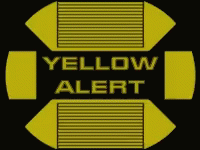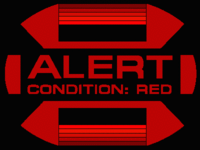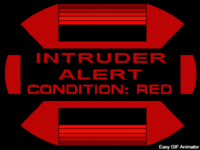Apollo-A Alert and Modes: Difference between revisions
(Created page with "{{Apollo-A Resources Nav}} {{LCARS-bar-nolink|Handbook|135|COLOR=darkred}} {{Apollo-A}} Category:USS Apollo-A") |
No edit summary |
||
| (11 intermediate revisions by the same user not shown) | |||
| Line 1: | Line 1: | ||
{{Apollo-A Resources Nav}} | {{Apollo-A Resources Nav}} | ||
{{LCARS-bar-nolink| | {{LCARS-bar-nolink|Alerts & Modes meanings for the Apollo-A|465|COLOR=darkred}} | ||
{{Apollo-A}} | {{Apollo-A}} | ||
{{LCARS-bar-heading|Apollo-A Operating Modes|280|COLOR=Maroon}} | |||
Though most Starfleet facilities carry out their duties without difficulty, Starfleet regulations detail a variety of operating modes for dealing with special situations, as well as the procedures to follow in each. Normal flight and mission operations of the Apollo-A are conducted per a variety of operating rules, determined by the current operating mode of the Ship. These operating modes are specified by the Commanding Officer, although in certain cases the computer can initiate Alert status upon detection of a potentially critical situation and any senior officers on the ship can change or call the alerts. | |||
{{Sub-Heading|green|Cruise Mode}} | |||
[[File:Green Alert.gif|200px|left]] | |||
Cruise Mode refers to the normal operating condition of the spacecraft. | |||
<br style="clear:left;"> | |||
{{Sub-Heading|goldenrod|Yellow Alert}} | |||
[[File:Yellow Alert.gif|200px|left]] | |||
A yellow alert or condition yellow was the second highest alert signal status on Starfleet vessels and starbases, one stage below red alert. It designated a ship-wide state of increased preparedness for possible crisis situations. | |||
In this status, a ship's defence fields are energised, and the deflector shields are brought to full power, but the weapons systems remained off-line. | |||
A yellow alert could either be activated manually by an environmentally hazardous situation, or automatically upon detection of a Proximity alert or Perimeter alert, or upon detection of certain system malfunctions. If the situation escalated, the commanding officer or the main computer would order a red alert. | |||
*'''Perimeter alert''': | |||
**A perimeter alert was an alert used by Starfleet, to warn about an approaching, unidentified starship. | |||
*'''Proximity alert''': | |||
**A proximity alert was an alert signal aboard a starship that indicated when another vessel was approaching. | |||
*'''Standby alert''': | |||
**A standby alert was a type of alert signal used to prepare a starship against possible threats. | |||
*'''Decompression Alert''': | |||
**Decompression Alert is usually declared when the computer of a starship, using internal sensors, detects decompressions on a deck of a starship. This alarm usually sounds when there is a hull breach. The computer usually will alert the bridge of decompression and tell them the deck; it is then the bridge crew's responsibility to evacuate those decks. | |||
{{Sub-Heading|red|Red Alert}} | |||
[[File:Red Alert.gif|200px|left]] | |||
A Red Alert (also condition red or code red or general quarters) is the highest emergency alert on a Starfleet starship. | |||
<br style="clear:left;"> | |||
When Red Alert is called, a loud warning klaxon begins blaring, accompanied by flashing red warning lights. All Starfleet personnel are required to report to duty stations — even those who were sleeping at the time. In addition to this, there are some things that occur once a red alert is sounded: | |||
*The ship's weapons - phasers and photon torpedoes/Quantum torpedoes - are brought to ready status. | |||
*All crew members are to report to duty, whether that be their primary duty station or a secondary duty station within five minutes. Those crew members asleep at the time are to report to duty within fifteen minutes. | |||
*Secondary stations can include medical duty. On larger ships, a good portion of the crew receives training as medical technicians. Much of the crew is used as "damage control", where the crewmembers presumably help to fix minor damage to the ship and perform basic engineering tasks, under the direction of the primary engineering team. | |||
*The deflector shields are brought to full power and raised. | |||
*On starships that can separate the saucer section, the crew prepares for possible separation. | |||
*Backup crews for the main bridge standby in the event separation is called for. | |||
*Crews for the battle bridge also go on standby status in case separation is called for. | |||
*The non-essential crew and other individuals (such as civilians and mission specialists) are moved to the saucer section. | |||
*The security division also makes some preparations. | |||
**They make sure escape pods access ways are clear so that if crewmembers and civilians need to evacuate the starship, they can get to the escape pods without any interruption. | |||
**Security teams are stationed at key areas throughout the ship. | |||
**Sensors record and track the locations of all individuals aboard the ship. This is used to determine if unauthorised access by an intruder occurs. (The ship's computer also helps with this function) | |||
**All security teams are placed on standby status in all areas of the ship. | |||
The red alert could also be ordered during various other emergency situations, such as a ship being boarded, radiation exposure, a security alert, massive systems failure, an imminent warp core breach, and evacuation order, among others. | |||
Engaging Self-destruct automatically triggers Red Alert. | |||
*'''Battle Stations''': | |||
**Battle stations was a general alarm used in naval operations (such as those that influenced the policies of Starfleet) when a starship was going into battle. On Federation starships, a battle stations alarm was usually made in addition to a red alert. | |||
*'''Evacuation Alert''': | |||
**An evacuation alert, or evacuation alarm, was used to signal a mandatory evacuation of a certain deck, ship, planet, or starbase. It was normally used during a catastrophic event such as a hull breach or a loss of antimatter containment. This was a higher alert state than battle stations or red alert. | |||
*'''Ultimate code''': | |||
**The ultimate code or ultimate override was a distress call signal in use in the United Federation of Planets that overrode all other communications and missions of a Starfleet starship and required them to respond. | |||
**The code was so highly classified that starship commanding officers were forbidden to submit an ultimate code to the computer for decoding. Instead, commanders had to memorise a key which allowed them to decode the message into a coherent form. Nor could the starship commander keep a computer record of the code. | |||
**The ultimate code was only to be used in the most extreme of circumstances. This included an attack by an alien force, a disaster, or an unforeseen scientific development, and also a provision for a danger that had not yet been anticipated. Misuse of the ultimate code was a crime in the Federation. Starships operating under the ultimate code were required to observe radio silence and were expected to approach at battle stations. | |||
*'''Double Red Alert''': | |||
**The double red alert was a rarely used alert signal for extremely dire situations, especially when a nearly instantaneous response was required. A double red alert was technically equivalent to a red alert, except that it conveyed a higher sense of urgency. The alarms and lights for a double red alert were the same as for a standard red alert. | |||
{{Sub-Heading|blue|Blue Alert}} | |||
[[File:Blue Alert.gif|200px|left]] | |||
Blue alert (also code blue or condition blue) was an alert signal status on Starfleet vessels and outposts which was called for in exceptional situations, including, but not limited to, environmental hazards to the crew, main power failure, docking and separation manoeuvres, entering or leaving space facilities and landing protocols, for ships with the capability. | |||
*'''External Support Mode''': | |||
**This is a state of reduced system operations typically invoked when the ship is docked at a starbase and is at least partially dependent on external power or environmental support systems. | |||
*'''Separated Flight Mode''': | |||
**This is a set of operating protocols used when the Saucer Module has separated from the Stardrive Section. Note that many Red Alert operating rules apply, since such separation is typically for combat situations. Separated Flight Mode is not available on all starships. | |||
{{Sub-Heading|grey|Grey Alert Mode}} | |||
Gray mode was an alert status used aboard Federation starships. | |||
When in Grey mode, the starship ran on reserve power, cutting power to non-essential decks and ship systems. It allowed for maximum power conservation, budgeting a starship's energy resources during a time of crisis, while still maintaining an operating status. Gray mode could be invoked during a massive fuel shortage, or when the tactical situation required a reduction in discretionary energy usage. | |||
The number of ship systems were either reduced to a lower operating status or shut down completely, including: | |||
*The warp core, which was brought to a cold shutdown | |||
*Inertial damping and structural integrity systems, which were operated at the minimum output | |||
*Tactical and lateral sensors, which were only used for primary ship functions | |||
*Deflector systems, which were either shut down or reduced to minimum levels for non-flight operation | |||
*Weapons systems, phasers and photon torpedo launchers, were brought off-line | |||
*Shuttlebay operations were suspended, as the shuttlecraft could provide energy support if necessary | |||
*Life support systems were brought to minimum levels and shut down on non-essential decks | |||
*Transporter usage was terminated | |||
*Turbolift usage would be suspended at the commanding officer's discretion | |||
*Food replicator was not used, and emergency rations were distributed | |||
*Holodeck or holosuite usage was terminated | |||
*The recycling of non-essential items, which could be broken down into raw matter patterns by the replicator, was commonly practised. Preserving the replicator for use only during critical situations (such as replicating repair tools, medicine, etc.) could help extend the energy resources of the ship. | |||
Starships were often forced into this condition, due to tactical situations or spatial phenomena, which can also coincide with a red alert. | |||
{{LCARS-bar-heading|Security alert|180|COLOR=Maroon}} | |||
A security alert was a type of alert signal aboard starships and space stations, primarily for internal security purposes. It was similar to an intruder alert and could be initiated explicitly by personnel or triggered by predefined parameters. | |||
*'''Security Condition One''': | |||
This is the Same as Red Alert And Red Alert, Battlestations. | |||
*'''Security Condition Two''': | |||
An ordered of level 2 security alert after it was learned that a faction the Borg had changed their entire existence and a new objective. They were no longer interested in acquiring cultures and technology. Armed guards were posted on every deck with anti borg weaponry. | |||
*'''Security Condition Three''': | |||
Indicated that ship's security had been compromised and an intruder was aboard the ship. | |||
*'''Security Condition Four''': | |||
Ordering all halls to be sealed off and all weapons to be accounted for and locked away on all levels of the ship. All Security officer on and off duty to report to there designated position fully armed with orders to use any force needed. | |||
*'''Security Condition Five''': | |||
When any crewmember on the ship has had their body taken over. Security officers to be fully armed and attempt to contain the crewmembers by any means necessary. | |||
*'''Security Condition Six''': | |||
*'''Security Condition Seven''': | |||
*'''Security Condition Eight''': | |||
*'''Security Condition Nine''': | |||
*'''Security Condition Ten''': | |||
The action also confined non-essential personnel to quarters and the posting of security teams on all decks. | |||
[[File:Intruder Alert.gif|200px|left]] | |||
*'''Intruder Alert''': | |||
Intruder alert was an alert status on Federation starships and space stations. It could be declared at any time, by computer or any crewmember upon detecting an intruder on board. It could also be activated automatically based on predefined criteria, such as entering a restricted area. The alert was announced by audio and crewmembers were expected to take appropriate action also Security Condition Three was implemented and on some occasions raised to Security Condition Four and Red Alert Sounded. | |||
[[Category:USS Apollo-A]] | [[Category:USS Apollo-A]] | ||
Latest revision as of 12:56, 17 October 2018
| USS Apollo-A Officer Resources
| |
|---|---|
| Edit This NAV |
| Alerts & Modes meanings for the Apollo-A |
|---|
| USS Apollo-A | ||
|---|---|---|
 INACTIVE STATUS | ||
| ||
Apollo-A Operating Modes
Though most Starfleet facilities carry out their duties without difficulty, Starfleet regulations detail a variety of operating modes for dealing with special situations, as well as the procedures to follow in each. Normal flight and mission operations of the Apollo-A are conducted per a variety of operating rules, determined by the current operating mode of the Ship. These operating modes are specified by the Commanding Officer, although in certain cases the computer can initiate Alert status upon detection of a potentially critical situation and any senior officers on the ship can change or call the alerts.
Cruise Mode |
Cruise Mode refers to the normal operating condition of the spacecraft.
Yellow Alert |
A yellow alert or condition yellow was the second highest alert signal status on Starfleet vessels and starbases, one stage below red alert. It designated a ship-wide state of increased preparedness for possible crisis situations.
In this status, a ship's defence fields are energised, and the deflector shields are brought to full power, but the weapons systems remained off-line.
A yellow alert could either be activated manually by an environmentally hazardous situation, or automatically upon detection of a Proximity alert or Perimeter alert, or upon detection of certain system malfunctions. If the situation escalated, the commanding officer or the main computer would order a red alert.
- Perimeter alert:
- A perimeter alert was an alert used by Starfleet, to warn about an approaching, unidentified starship.
- Proximity alert:
- A proximity alert was an alert signal aboard a starship that indicated when another vessel was approaching.
- Standby alert:
- A standby alert was a type of alert signal used to prepare a starship against possible threats.
- Decompression Alert:
- Decompression Alert is usually declared when the computer of a starship, using internal sensors, detects decompressions on a deck of a starship. This alarm usually sounds when there is a hull breach. The computer usually will alert the bridge of decompression and tell them the deck; it is then the bridge crew's responsibility to evacuate those decks.
Red Alert |
A Red Alert (also condition red or code red or general quarters) is the highest emergency alert on a Starfleet starship.
When Red Alert is called, a loud warning klaxon begins blaring, accompanied by flashing red warning lights. All Starfleet personnel are required to report to duty stations — even those who were sleeping at the time. In addition to this, there are some things that occur once a red alert is sounded:
- The ship's weapons - phasers and photon torpedoes/Quantum torpedoes - are brought to ready status.
- All crew members are to report to duty, whether that be their primary duty station or a secondary duty station within five minutes. Those crew members asleep at the time are to report to duty within fifteen minutes.
- Secondary stations can include medical duty. On larger ships, a good portion of the crew receives training as medical technicians. Much of the crew is used as "damage control", where the crewmembers presumably help to fix minor damage to the ship and perform basic engineering tasks, under the direction of the primary engineering team.
- The deflector shields are brought to full power and raised.
- On starships that can separate the saucer section, the crew prepares for possible separation.
- Backup crews for the main bridge standby in the event separation is called for.
- Crews for the battle bridge also go on standby status in case separation is called for.
- The non-essential crew and other individuals (such as civilians and mission specialists) are moved to the saucer section.
- The security division also makes some preparations.
- They make sure escape pods access ways are clear so that if crewmembers and civilians need to evacuate the starship, they can get to the escape pods without any interruption.
- Security teams are stationed at key areas throughout the ship.
- Sensors record and track the locations of all individuals aboard the ship. This is used to determine if unauthorised access by an intruder occurs. (The ship's computer also helps with this function)
- All security teams are placed on standby status in all areas of the ship.
The red alert could also be ordered during various other emergency situations, such as a ship being boarded, radiation exposure, a security alert, massive systems failure, an imminent warp core breach, and evacuation order, among others.
Engaging Self-destruct automatically triggers Red Alert.
- Battle Stations:
- Battle stations was a general alarm used in naval operations (such as those that influenced the policies of Starfleet) when a starship was going into battle. On Federation starships, a battle stations alarm was usually made in addition to a red alert.
- Evacuation Alert:
- An evacuation alert, or evacuation alarm, was used to signal a mandatory evacuation of a certain deck, ship, planet, or starbase. It was normally used during a catastrophic event such as a hull breach or a loss of antimatter containment. This was a higher alert state than battle stations or red alert.
- Ultimate code:
- The ultimate code or ultimate override was a distress call signal in use in the United Federation of Planets that overrode all other communications and missions of a Starfleet starship and required them to respond.
- The code was so highly classified that starship commanding officers were forbidden to submit an ultimate code to the computer for decoding. Instead, commanders had to memorise a key which allowed them to decode the message into a coherent form. Nor could the starship commander keep a computer record of the code.
- The ultimate code was only to be used in the most extreme of circumstances. This included an attack by an alien force, a disaster, or an unforeseen scientific development, and also a provision for a danger that had not yet been anticipated. Misuse of the ultimate code was a crime in the Federation. Starships operating under the ultimate code were required to observe radio silence and were expected to approach at battle stations.
- Double Red Alert:
- The double red alert was a rarely used alert signal for extremely dire situations, especially when a nearly instantaneous response was required. A double red alert was technically equivalent to a red alert, except that it conveyed a higher sense of urgency. The alarms and lights for a double red alert were the same as for a standard red alert.
Blue Alert |
Blue alert (also code blue or condition blue) was an alert signal status on Starfleet vessels and outposts which was called for in exceptional situations, including, but not limited to, environmental hazards to the crew, main power failure, docking and separation manoeuvres, entering or leaving space facilities and landing protocols, for ships with the capability.
- External Support Mode:
- This is a state of reduced system operations typically invoked when the ship is docked at a starbase and is at least partially dependent on external power or environmental support systems.
- Separated Flight Mode:
- This is a set of operating protocols used when the Saucer Module has separated from the Stardrive Section. Note that many Red Alert operating rules apply, since such separation is typically for combat situations. Separated Flight Mode is not available on all starships.
Grey Alert Mode |
Gray mode was an alert status used aboard Federation starships.
When in Grey mode, the starship ran on reserve power, cutting power to non-essential decks and ship systems. It allowed for maximum power conservation, budgeting a starship's energy resources during a time of crisis, while still maintaining an operating status. Gray mode could be invoked during a massive fuel shortage, or when the tactical situation required a reduction in discretionary energy usage.
The number of ship systems were either reduced to a lower operating status or shut down completely, including:
- The warp core, which was brought to a cold shutdown
- Inertial damping and structural integrity systems, which were operated at the minimum output
- Tactical and lateral sensors, which were only used for primary ship functions
- Deflector systems, which were either shut down or reduced to minimum levels for non-flight operation
- Weapons systems, phasers and photon torpedo launchers, were brought off-line
- Shuttlebay operations were suspended, as the shuttlecraft could provide energy support if necessary
- Life support systems were brought to minimum levels and shut down on non-essential decks
- Transporter usage was terminated
- Turbolift usage would be suspended at the commanding officer's discretion
- Food replicator was not used, and emergency rations were distributed
- Holodeck or holosuite usage was terminated
- The recycling of non-essential items, which could be broken down into raw matter patterns by the replicator, was commonly practised. Preserving the replicator for use only during critical situations (such as replicating repair tools, medicine, etc.) could help extend the energy resources of the ship.
Starships were often forced into this condition, due to tactical situations or spatial phenomena, which can also coincide with a red alert.
Security alert
A security alert was a type of alert signal aboard starships and space stations, primarily for internal security purposes. It was similar to an intruder alert and could be initiated explicitly by personnel or triggered by predefined parameters.
- Security Condition One:
This is the Same as Red Alert And Red Alert, Battlestations.
- Security Condition Two:
An ordered of level 2 security alert after it was learned that a faction the Borg had changed their entire existence and a new objective. They were no longer interested in acquiring cultures and technology. Armed guards were posted on every deck with anti borg weaponry.
- Security Condition Three:
Indicated that ship's security had been compromised and an intruder was aboard the ship.
- Security Condition Four:
Ordering all halls to be sealed off and all weapons to be accounted for and locked away on all levels of the ship. All Security officer on and off duty to report to there designated position fully armed with orders to use any force needed.
- Security Condition Five:
When any crewmember on the ship has had their body taken over. Security officers to be fully armed and attempt to contain the crewmembers by any means necessary.
- Security Condition Six:
- Security Condition Seven:
- Security Condition Eight:
- Security Condition Nine:
- Security Condition Ten:
The action also confined non-essential personnel to quarters and the posting of security teams on all decks.
- Intruder Alert:
Intruder alert was an alert status on Federation starships and space stations. It could be declared at any time, by computer or any crewmember upon detecting an intruder on board. It could also be activated automatically based on predefined criteria, such as entering a restricted area. The alert was announced by audio and crewmembers were expected to take appropriate action also Security Condition Three was implemented and on some occasions raised to Security Condition Four and Red Alert Sounded.






